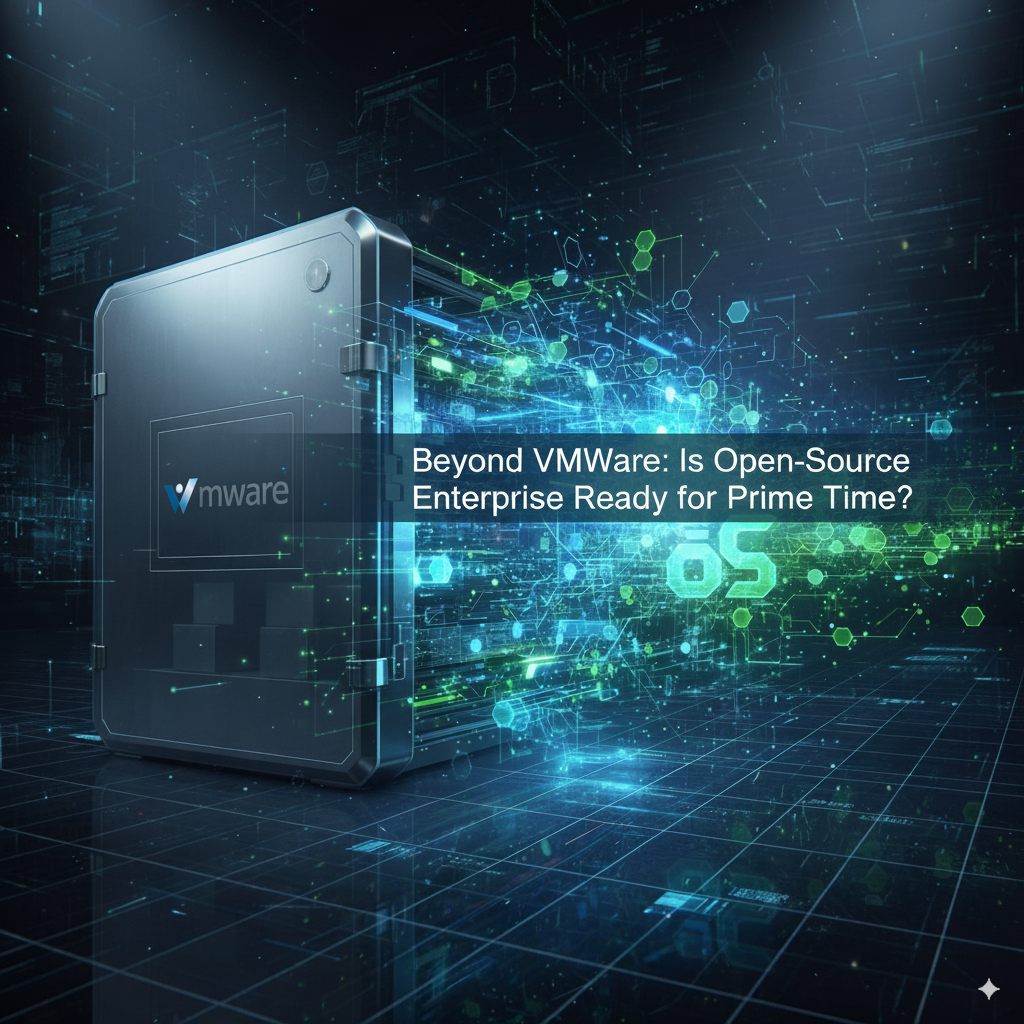Beyond VMware: Is Open-Source Enterprise Ready, for Prime Time?
Beyond VMware: Is Open-Source Enterprise Ready, for Prime Time?

For years, VMware was the default choice for enterprise virtualization. Its performance and reliability justified the premium. But Broadcom’s licensing changes have fundamentally altered the economics. As we explored earlier, going halfway with VCF erodes ROI, while full-stack adoption requires an all-in commitment at significant cost.
That raises the strategic question: if staying has become expensive, is leaving truly viable?
The answer lies in a trend already shaping the enterprise stack: enterprise-grade open source.
The Precedent: How “Free” Code Became Enterprise Bedrock
CIOs and CFOs already live this model: the open-source engine powers innovation, while commercial vendors wrap it with enterprise features, support, and accountability.
- Kubernetes (Google → CNCF): Open source became the container standard. Enterprises buy Red Hat OpenShift, VMware Tanzu, or managed services (EKS, AKS, GKE).
- Linux (Community → Red Hat/SUSE): The kernel is free. RHEL turned it into a multi-billion-dollar subscription business.
- Terraform (HashiCorp): Began open source, now monetized via BSL licensing and Terraform Cloud.
- Elasticsearch / MongoDB: Both shifted licenses to protect enterprise offerings (Elastic Cloud, MongoDB Atlas).
The pattern is consistent: open source delivers the engine; enterprises pay for the steering wheel, dashboard, and 24/7 roadside assistance.
The Virtualization Alternative: OpenStack + KVM
Virtualization has followed the same trajectory. KVM, built into the Linux kernel, is a mature, enterprise-tested hypervisor. OpenStack adds the cloud management layer covering compute, storage, networking, and orchestration.
Several vendors now package these technologies into hardened, fully supported enterprise distributions:
- Red Hat OpenStack Platform (RHOSP) The “RHEL of private cloud.” Backed by IBM, trusted in mission-critical industries. Best for large-scale, highly regulated workloads.
- Virtuozzo Hybrid Infrastructure (VHI) The cost-efficient contender. Packages OpenStack + KVM with integrated storage into a single platform. Its cloudlet-based consumption model can reduce TCO by 50–70% compared to VCF. With dedicated engineering support and a VMware-like experience, it is attractive for service providers and mid-market enterprises looking for agility without vendor lock-in.
- Canonical Charmed OpenStack Lean, automation-driven, and DevOps-friendly. Designed for fast-moving organizations and those who already rely on Ubuntu in their stack.
- Mirantis OpenStack Services-led, flexible, and engineered for complex scenarios like telco NFV or distributed edge environments.
The CIO Decision Framework
The technical capability question is already answered—these platforms run hyperscaler-scale workloads today. The real question is strategic alignment:
- Need: Existing Red Hat investment, enterprise scale. Consider: RHOSP.
- Need: Turnkey VMware replacement, lower TCO, flexible commercial model. Consider: Virtuozzo Hybrid Infrastructure.
- Need: Automation, DevOps culture, lower operational overhead. Consider: Canonical Charmed OpenStack.
- Need: Customized architectures for specific industries (telco, edge). Consider: Mirantis.
The Bottom Line
Enterprise IT has already embraced open-source economics across Linux, Kubernetes, databases, and automation. Virtualization is simply the next domino.
The cost of staying with VMware has increased dramatically, but the cost of leaving is no longer prohibitive. The shift to open-source virtualization isn’t a gamble, it’s a strategic rebalancing toward open, flexible, and cost-effective platforms.
For CIOs, the prudent move isn’t to decide today, but to evaluate seriously.
In an era where licensing changes can redraw the rules overnight, optionality is leverage.
Coming Next: I’ll shift focus from CIO strategy to the CFO’s lens.
We’ll break down the real numbers behind Broadcom’s new licensing from per-socket to per-core, the 72-core minimum, and the bundled VCF model.
Spoiler: the TCO math is not pretty. Stay tuned for A CFO’s TCO Analysis.
Written by Syed Waqar Uddin - Chief Cloud Architect specializing in platform engineering and cloud architecture.